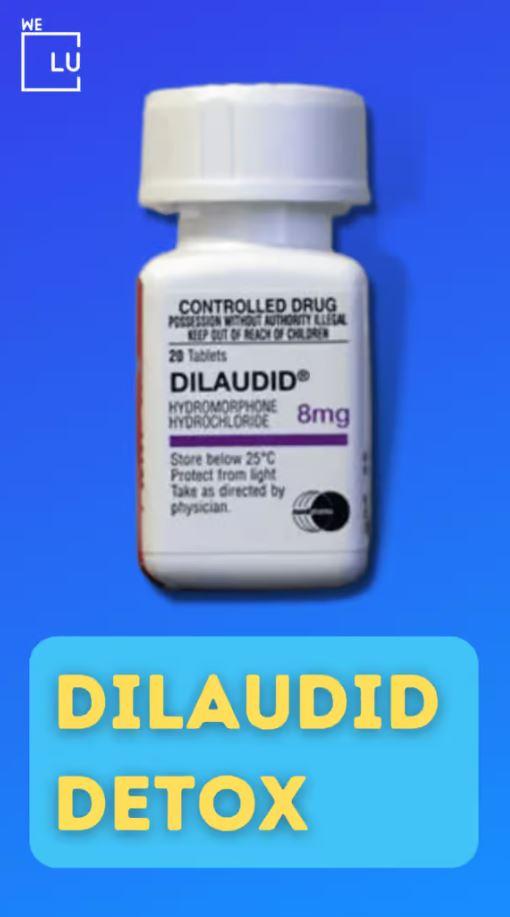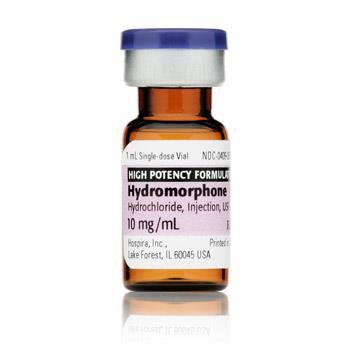Dilaudid Detox, Withdrawal Symptoms, Timeline & Treatment
Dilaudid detox, or detoxification from hydromorphone, can provide a number of benefits for individuals struggling with addiction to this potent opioid painkiller. Addiction to Dilaudid can be all-consuming, making it difficult to maintain relationships, work, or participate in everyday activities. Detoxing from Dilaudid can help individuals regain control of their lives and improve their overall quality of life. Read more about Dilaudid detox, withdrawal management, and the best treatment options you can explore.
By We Level Up | Editor Yamilla Francese | Clinically Reviewed By Lauren Barry, LMFT, MCAP, QS, Director of Quality Assurance | Editorial Policy | Research Policy | Last Updated: May 12, 2023
Dilaudid Detox Overview
If you have a Dilaudid addiction, detoxification is one of the most crucial steps to overcoming it. At We Level Up, we offer a Dilaudid detox process to help you begin healing. Dilaudid (brand name for the drug hydromorphone) is a powerful synthetic narcotic that belongs to the opioid Schedule II controlled substance class of drugs. Opioids are natural or artificial versions of chemicals that come from the opium poppy plant.
When used correctly, Dilaudid can help with moderate to severe pain due to operations, burns, and cancer treatment, but the risk of developing an addiction is high. Dilaudid attaches itself to the receptors in the central nervous system and brain, dulling pain. It also triggers the release of high levels of dopamine, causing pleasure. This flood of dopamine activates the reward center in the brain. With regular use, your brain may stop making dopamine, relying instead on the drug.
How quickly the effects of Dilaudid begin depends on the form of administration, but they can last for a few hours. Those with a Dilaudid addiction tend to inject or mix the drug with alcohol or benzodiazepines, which is highly hazardous. Unfortunately, you can build a dependence on the drug in as little as two weeks of using it.
Dilaudid Withdrawal Timeline
Dilaudid withdrawal symptoms can begin within hours of the last dose of Dilaudid and peak within the first few days before gradually subsiding. Here is a general timeline of Dilaudid withdrawal symptoms:
| The first 24 hours. | Within a few hours after the previous dose of Dilaudid, withdrawal symptoms can begin, including anxiety, restlessness, insomnia, muscle aches, sweating, and stomach cramps. |
| Days 2-4. | Symptoms typically peak during this period, including intense cravings, nausea and vomiting, diarrhea, goosebumps, dilated pupils, and elevated heart rate and blood pressure. |
| Days 5-7. | Symptoms generally begin to subside during this period, but individuals may still experience lingering symptoms such as fatigue, depression, and insomnia. |
Dilaudid Withdrawal Symptoms
We Level Up offers medical detox for people struggling with Dilaudid addiction, allowing them to avoid the worst withdrawal symptoms. If you attempt to go through the detox process alone, you can put yourself at risk of relapsing and even put your health in danger. Some of the Dilaudid withdrawal symptoms include the following:
- Muscle and bone pain.
- Diarrhea.
- Anxiety.
- Restlessness.
- Runny nose.
- Shaking.
- Vomiting.
- Agitation.
- Elevated blood pressure.
- Depression.
- Goosebumps.
- Chills and shivering.
- Dilated pupils.
- Restlessness.
- Nausea.
- Irritability.
- Confusion.
- Suicidal ideation.
- Fever.
- Muscle spasms.
The Dilaudid withdrawal timeline differs from person to person based on factors like your usual dosage, your health, and the severity of your addiction. Our experienced staff can conduct a thorough interview and give you an idea of how long the process takes for people with circumstances similar to yours.
Hydromorphone Withdrawal Symptoms
Hydromorphone, sold under the brand Dilaudid, produces withdrawal symptoms that can be intense and uncomfortable and may vary based on the individual’s level and length of use, as well as other factors such as age, general health, and mental health. Here are some common hydromorphone withdrawal symptoms:
- Restlessness and agitation: Individuals may feel irritable, anxious, and restless.
- Insomnia: The problem of staying or falling asleep is a common symptom during hydromorphone withdrawal.
- Muscle aches: Hydromorphone withdrawal can cause muscle pain, cramps, and stiffness.
- Sweating: Sweating and hot flashes are common during hydromorphone withdrawal.
- Stomach cramps and diarrhea: Hydromorphone can cause gastrointestinal issues, and withdrawal can worsen these symptoms.
- Nausea and vomiting: Individuals may experience nausea and vomiting during hydromorphone withdrawal.
- Dilated pupils: Hydromorphone withdrawal can cause pupils to become enlarged.
- Goosebumps: Hydromorphone withdrawal can cause goosebumps or “gooseflesh.”
- Elevated heart rate and blood pressure: Hydromorphone withdrawal can cause increased heart rates.
- Cravings: Individuals may experience intense cravings for hydromorphone during withdrawal.

Skip To:
Learn More:
- Opiate Detox Timeline, Withdrawal Symptoms, & Top Treatment Options
- How Long Do Drugs Stay in Your System Chart? Drug Half-Life. Drug Tests Duration. How Long Do Drugs Stay in Your System?
- Opioid Addiction Treatment
- Opioid Overdose Symptoms
- Opioid Withdrawal Timeline
- Opioid Withdrawal Symptoms
- Prescription Pill Detox Program
- Prescription Drugs Addiction
- 10 Most Abused Prescription Drugs In The US
- Withdrawal Symptoms of Prescription Drugs
People with pre-existing cardiac conditions or other medical disorders may find their symptoms aggravated by Dilaudid withdrawal. They may experience a rapid pulse and an elevation in blood pressure. People with anxiety disorders, particularly panic disorders, may intensify their symptoms during detox. Similarly, people with pain conditions will likely experience increased pain during detoxification.
At We Level Up, we offer medical detox to help with Dilaudid withdrawal symptoms, allowing you to begin your recovery with comfort and 24/7 medical assistance if you need it.
Dilaudid Drug Facts
Generic Name: Hydromorphone (oral) (HYE-Droe-MOR-fone)
Drug Class: Opioids (narcotic analgesics)
Brand names: Dilaudid, Hydrostat IR, Exalgo
Basics of Dilaudid Addiction
The National Library of Medicine states that three million Americans have had or currently have an addiction to painkillers. One common type of painkiller that is highly addictive is Dilaudid.
Some risk factors can make someone more prone to developing a Dilaudid addiction. Genetics and family history can play a significant role, as people with a close family member who abuses Dilaudid are much more likely to do so. Some of the most common signs of a Dilaudid addiction include the following:
- Apathy.
- Slurred speech.
- Spending time and effort getting the drug.
- Taking Dilaudid in more significant quantities than prescribed.
- Constricted pupils.
- Doctor shopping.
- Drowsiness.
- Withdrawal symptoms.
- Developing tolerance.
- Euphoria.
- Poor memory.
- Poor concentration.
- Impaired judgment.
- Depression.
Dilaudid is a dangerous drug that can cause various health problems if misused, but help is available. If you have a Dilaudid addiction, contact our team at We Level Up to begin your recovery with Dilaudid detox.
How Long Does Dilaudid Work?
When taken orally in tablet or capsule form, Dilaudid typically takes about 15-30 minutes to start working, with peak effects occurring within 30-60 minutes. The effects can last for 4-6 hours. How long does Dilaudid last in IV? When administered intravenously (IV) or intramuscularly (IM), Dilaudid has a faster onset of action, with effects typically occurring within 5-10 minutes. The duration of effects can last for 2-3 hours.

Dilaudid Overdose Symptoms
It is essential to understand that Dilaudid can be very dangerous if used more extended periods than prescribed, in higher doses than prescribed, or with other substances.
Because tolerance builds so quickly, the risk of overdosing is also high. Some of the signs of a Dilaudid overdose include:
- Pinpoint pupils.
- Vomiting.
- Bluish lips.
- Shallow breathing.
- Weak pulse.
- Extreme fatigue.
- Disorientation.
- Unconsciousness.
- Fainting.
- Dizziness.
- Muscle spasms.
- Low blood pressure.
- Cold or clammy skin.
Beginning Recovery With A Dilaudid Detox
Before you can focus on understanding the underlying causes of your addiction, you have to remove traces of the drug from your body in what is known as the detox process.
While this sounds simple, Dilaudid detox consists of intense withdrawal symptoms that can be difficult to tolerate without medical assistance. This step is imperative. If you suffer from addiction and fail during detox and relapses, you will likely try using the drug again.
How Long Does Dilaudid Stay In Your System?
Dilaudid can be detected in various biological samples such as urine, blood, saliva, and hair for different periods. Here are some approximate detection times:
- Urine: Dilaudid can be seen in urine for 1-4 days after use.
- Blood: Dilaudid can be detected up to 24 hours after use.
- Saliva: Dilaudid can be detected in saliva for up to 1-4 days after the last use.
- Hair: Dilaudid can be seen in hair for up to 90 days after use.
Generally, Dilaudid has a half-life of approximately 2-3 hours, which means it takes the body to eliminate half of Dilaudid from the system. However, it can take several half-lives for the drug to be eliminated from the body.

Get Your Life Back
Find Hope & Recovery. Get Safe Comfortable Detox, Addiction Rehab & Dual Diagnosis High-Quality Care.
Hotline(844) 597-1011Dilaudid Addiction Statistics
The latest research for opioid use disorder revealed that up to 41% of individuals who received hydromorphone for medical purposes developed some dependence. These statistics highlight the prevalence of Dilaudid addiction and the need for effective prevention, treatment, and recovery resources for those struggling with opioid use disorders.
1.6 Million
An estimated 1.6 million US citizens aged 12 or older used hydromorphone (the active ingredient in Dilaudid) for non-medical purposes in 2019.
Source: NSDUH
5,500
The Centers for Disease Control and Prevention reports that hydromorphone was involved in over 5,500 overdose deaths in the United States in 2018.
Source: CDC
26%
Opioid use disorder was present in up to 26% of patients receiving palliative care with hydromorphone.
Source: NCBI
Withdrawal Dilaudid Management
A medically-assisted Dilaudid detox is required to avoid the higher risk of lethal Dilaudid overdose. Detoxification from Dilaudid can help individuals safely manage Dilaudid withdrawal symptoms and reduce the risk of overdose. Dilaudid is a powerful opioid pain medication that can lead to dependence and addiction. Overdose is a severe risk for individuals who misuse Dilaudid or take more than the prescribed dose.
During detoxification, individuals are gradually weaned off Dilaudid under medical supervision. This can involve using medications to manage withdrawal symptoms and medical monitoring to ensure safety and manage any complications that may arise.
Detoxification from Dilaudid is just the first step in addressing opioid use disorder. After detoxification, individuals may benefit from ongoing treatment and support to address the underlying issues related to addiction and develop strategies for long-term recovery. This can include behavioral therapies, medication-assisted treatment, and support from peer groups and addiction specialists.
If you or someone you’re concerned with is struggling with Dilaudid addiction, seeking professional help is crucial. Opioid use disorder is a severe medical condition that requires comprehensive treatment and ongoing support.

Get Help. Get Better. Get Your Life Back.
Searching for Accredited Drug and Alcohol Rehab Centers Near You?
Even if you have failed previously and relapsed, or are in the middle of a difficult crisis, we stand ready to support you. Our trusted behavioral health specialists will not give up on you. When you feel ready or just want someone to speak to about therapy alternatives to change your life call us. Even if we cannot assist you, we will lead you to wherever you can get support. There is no obligation. Call our hotline today.
(844) 597-1011How Long Will Dilaudid Detox Take?
Dilaudid detox can take as long as a week or two. However, professional detox centers sometimes keep patients at the facility for several weeks, usually about a month, to ensure they are completely over their opioid dependence and ready to begin addiction treatment. Usually, opioid detox occurs in three stages.
Stage One. The Most Uncomfortable Stage of a Dilaudid Detox.
Though this stage only lasts about one to three days, it is the one most people fear and can be the most uncomfortable. If it were a regular-release medication, people would begin to experience withdrawal from Dilaudid about six to eight hours after using it. However, if the drug was an extended-release type, they may start feeling Dilaudid withdrawal effects 10 or 12 hours after their last dose. The symptoms you may experience during this stage typically include pain in the joints, bones, and muscles, flu-like symptoms, and anxiety.
Stage Two. The Longest Stage.
This stage usually is where people experience nausea, vomiting, diarrhea, and lingering effects from the previous step. Often, this stage lasts the longest, usually for four or more days. People going through this stage are highly susceptible to dehydration.
Medical supervision during this stage is crucial to ensure you are always safe and manage your cravings. Staying in the security of our detox facility during this challenging stage of recovery can prevent you from relapsing.
Stage Three. The Last Stage of a Dilaudid Detox.
During this stage, you may experience lingering Dilaudid withdrawal effects. Some people think they are through withdrawal when just sharing stage three. Therefore, it is critical to be extra careful when withdrawing and not return to your everyday life too quickly. Detox programs will often help people through this stage, lasting anywhere from one day to a week or more. It is essential never to leave treatment early, as this could lead to relapse.
First-class Facilities & Amenities
World-class High-Quality Addiction & Mental Health Rehabilitation Treatment
Rehab Centers TourRenowned Addiction Centers. Serene Private Facilities. Inpatient rehab programs vary.
Addiction Helpline(844) 597-1011Proven recovery success experience, backed by a Team w/ History of:
15+
Years of Unified Experience
100s
5-Star Reviews Across Our Centers
10K
Recovery Success Stories Across Our Network
- Low Patient to Therapist Ratio
- Onsite Medical Detox Center
- Comprehensive Dual-Diagnosis Treatment
- Complimentary Family & Alumni Programs
- Coaching, Recovery & Personal Development Events

Dilaudid Detox Medications
At We Level Up, we turn to certain medications to offer our patients relief from withdrawal symptoms as they undergo the Dilaudid detox process. We perform a detailed intake assessment of your mental and physical health to ensure we use the medications best suited to your needs.
Throughout the entire Dilaudid detox process, you will have medical supervision and checkups, monitoring the way you react to the individual drugs we provide. One of the drugs we use is buprenorphine. Buprenorphine can alleviate the pain and discomfort that withdrawal causes. We generally use it with naloxone, which blocks the euphoria that opioids can bring.
Methadone is another one of the medications we work with at We Level Up. It is one of the most common treatment medications for people suffering from opioid withdrawal. For people who have been off Dilaudid for at least seven days, we can turn to naltrexone. It functions in the body as an opioid antagonist. If you were to use it while Dilaudid was still in your system, you could experience severe withdrawal symptoms.
Clonidine is another option. It is a non-opioid to relieve anxiety, agitation, cramping, and tension. It also helps regulate blood pressure and pulse while reducing cravings.
Dilaudid Detox & Addiction Treatment Settings
Understanding that undergoing Dilaudid detox is not a substitute for a comprehensive addiction treatment program is essential. It can help you build the skills necessary to avoid relapse. Recovery is a long road that takes a lot of work, but finding a detox program is an excellent first step.
We Level Up offers residential treatment programs to help combat the intense symptoms of Dilaudid abuse and other substance use disorders. Inpatient treatment allows you to remove yourself from your typical environment, immersing yourself in a supportive and welcoming location with professionals ready to help you.
Opioid treatment can be complex, and you need to have people helping you right from the start.
Dilaudid Detox Treatment
Misuse or abuse of Dilaudid can increase the risk of adverse effects, including overdose, addiction, and withdrawal symptoms. Inpatient drug rehab is a standard treatment option for Dilaudid addiction. Inpatient rehab typically involves staying in a residential facility for some time, ranging from a few weeks to several months, based on the individual’s needs and the severity of the addiction.
Inpatient rehab programs typically provide a safe and structured setting where individuals can concentrate on their recovery without distractions or triggers from the outside world. They also offer 24/7 medical access and emotional support, which can be critical for individuals experiencing severe withdrawal symptoms or other complications.
You do not have to go through Dilaudid addiction recovery on your own. When you turn to We Level Up, you can receive the care you need and 24/7 monitoring to remain comfortable during detox. Our team is ready to help you reduce the severity of your Dilaudid withdrawal symptoms so you have a higher chance of achieving long-term recovery. Contact We Level Up right now to learn more about our detox programs.

World-class, Accredited, 5-Star Reviewed, Effective Addiction & Mental Health Programs. Complete Behavioral Health Inpatient Rehab, Detox plus Co-occuring Disorders Therapy.
CALL(844) 597-1011End the Addiction Pain. End the Emotional Rollercoaster. Get Your Life Back. Start Drug, Alcohol & Dual Diagnosis Mental Health Treatment Now. Get Free No-obligation Guidance by Substance Abuse Specialists Who Understand Addiction & Mental Health Recovery & Know How to Help.
Top 5 Dilaudid Withdrawal FAQs
-
Will Dilaudid cause withdrawal symptoms?
Yes, Dilaudid (hydromorphone) can cause withdrawal symptoms if used for a prolonged time or if it is abused or misused. Withdrawal symptoms occur as the body adjusts to the absence of Dilaudid and can be uncomfortable and potentially life-threatening.
-
How long do Dilaudid withdrawal symptoms last?
Dilaudid withdrawal symptoms can vary in intensity and duration based on the individual’s level, length of use, and other factors such as age, general health, and mental health. Dilaudid withdrawal symptoms can begin within hours of the last dose of Dilaudid and peak within the first few days before gradually subsiding.
-
How long does it take to detox from Dilaudid?
Generally, the acute phase of Dilaudid detoxification can last 5-7 days, during which time the individual will experience Dilaudid withdrawal symptoms as the body adjusts to the absence of the drug. The severity and duration of Dilaudid withdrawal symptoms can vary depending on the abovementioned factors and can also last from several weeks to several months. After the acute phase of detoxification, the individual may continue to experience post-acute withdrawal symptoms (PAWS), including insomnia, anxiety, mood swings, and physical symptoms. PAWS can linger for several weeks or months but typically improve over time.
-
How long does IV Dilaudid last?
Intravenous (IV) Dilaudid (hydromorphone) typically has a relatively short duration of action, lasting around 2-4 hours. However, tolerance to Dilaudid can develop over time, decreasing the drug’s course of action and increasing the risk of dependence and addiction.
-
How long does Dilaudid stay in your urine?
The detection window for Dilaudid (hydromorphone) in urine can differ based on several aspects, including the individual’s age, weight, overall health, the dose and frequency of using Dilaudid, and the method of administration. Dilaudid can generally be detected in urine for 2-4 days after the last dose.
How Long Do Opiates Stay in Your System? How Long Do Opiates Stay in Urine, Blood, & Body?
Get FREE addiction treatment insurance check – https://welevelup.com/rehab-insurance/ If you or a loved one is struggling with opiates addiction or other substance use disorder(s), call for a FREE consultation 24/7 at (561) 678-0917
How Long Do Opiates Stay in Your System? A Brief Video Transcript
Drugs in the opioid class are used to treat pain. Natural opioids, semi-synthetic opioids generated from natural opioids, and synthetic opioids produced in a lab are all referred to as opioids under the general term. A class of medications known as opioids contain opiates, which are organic byproducts of the poppy plant. The main difference is that “opiate” refers to the substances derived from the opium (poppy) plant. At the same time, “opioids” are all substances that interact with opioid receptors, including those created in the lab.
The length of time that opiates remain in your system varies depending on the type of opiate, the dosage, and the frequency of use. Generally, opiates can stay in your system for two to four days. However, heavier and chronic users may have residues in their system for up to seven days.
Opiates can be detected in the blood test for up to 24 hours and in the urine test for up to three days. Opiates can be detected in the hair follicles for up to 90 days. In chronic users, opiates can stay in the body for up to 30 days.
Opiates often have short half-lives, meaning their effects can linger for several hours even though they swiftly leave the body. However, Opioids can linger in a person’s bloodstream for several hours or days after the symptoms subside, depending on the substance used. Urine tests, one of the more common types of drug testing, can identify opioid usage for longer periods of time, often up to three to four days, and some tests can identify opioid use for up to three months.
Experience Transformative Recovery at We Level Up Treatment Centers.
See our authentic success stories. Get inspired. Get the help you deserve.
Start a New Life
Begin with a free call to an addiction & behavioral health treatment advisor. Learn more about our dual-diagnosis programs. The We Level Up Treatment Center Network delivers recovery programs that vary by each treatment facility. Call to learn more.
- Personalized Care
- Caring Accountable Staff
- World-class Amenities
- Licensed & Accredited
- Renowned w/ 100s 5-Star Reviews
We’ll Call You
Search We Level Up Dilaudid Detox, Mental Health Topics & Resources
Sources
[1] Hydromorphone – Available from MedlinePlus – https://medlineplus.gov/druginfo/meds/a682013.html U.S. Department of Health and Human Services National Institutes of Health
[2] Definition of Dilaudid – Available from: https://www.cancer.gov/publications/dictionaries/cancer-terms/def/dilaudid
[3] DILAUDID® ORAL LIQUID and DILAUDID® TABLETS – Food & Drug Administration (FDA)
[4] LiverTox: Clinical and Research Information on Drug-Induced Liver Injury [Internet]. Bethesda (MD): National Institute of Diabetes and Digestive and Kidney Diseases; 2012-. Hydromorphone. [Updated 2020 Nov 24]. Available from: https://www.ncbi.nlm.nih.gov/books/NBK548775/
[5] HYDROMORPHONE – Available from: https://www.deadiversion.usdoj.gov/drug_chem_info/hydromorphone.pdf
[6] Shah M, Huecker MR. Opioid Withdrawal. [Updated 2023 Jan 17]. In: StatPearls [Internet]. Treasure Island (FL): StatPearls Publishing; 2023 Jan-. Available from: https://www.ncbi.nlm.nih.gov/books/NBK526012/
[7] U.S. National Library of Medicine. (2013). Opiate Withdrawal. Retrieved on October 21, 2015, from: https://www.nlm.nih.gov/medlineplus/ency/article/000949.htm
[8] Ruiz, Pedro, and Eric Strain. Substance Abuse: A Comprehensive Textbook, Fifth Edition. Philadelphia, PA. 2011.
[9] U.S. National Library of Medicine. (2015). Burprenorphine Sublingual and Buccal. Retrieved on October 21, 2015, from: https://www.nlm.nih.gov/medlineplus/druginfo/meds/a605002.html
[10] Abi-Aad KR, Derian A. Hydromorphone. [Updated 2022 Jul 11]. In: StatPearls [Internet]. Treasure Island (FL): StatPearls Publishing; 2023 Jan-. Available from: https://www.ncbi.nlm.nih.gov/books/NBK470393/


